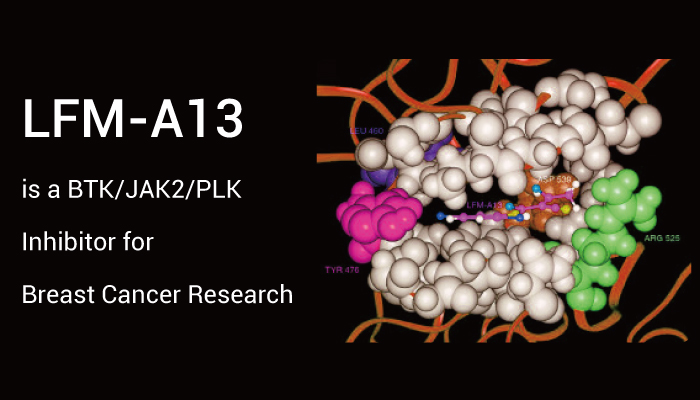Breast cancer is the most common cancer in women all over the world. Breast cancer development is associated with abnormal cell proliferation and defects in apoptosis. Noticeably, Polo-like Kinases (PLKs) are a group of highly conserved serine/threonine protein kinases, and is overexpressed in cancer cells. PLKs can regulate mitosis and apoptosis. PLK inhibitors are a new class of chemosensitizing anti-proliferative agents against breast cancer. Besides, BTK is an apoptotic protein, and is critical in B-cell antigen receptor (BCR)-signaling and B-cell activation. BTK Inhibitors can enhance the chemosensitivity of leukemia/lymphoma cells. Therefore, LFM-A13, a dual BTK/PLK Inhibitor, is a potent anti-tumor agent against breast cancer.

LFM-A13, a potent BTK/PLK Inhibitor, has anti-proliferative and anticancer activity in breast cancer.
In vitro, LFM-A13 inhibits recombinant BTK, Plx1 and PLK3 with IC50s of 2.5 μM, 10 μM and 61 μM respectively. LFM-A13 (500 μM, water-borne administration) also blocks the cell division in a zebrafish embryo model at the 16-cell stage of the embryonic development. In addition, in human breast cancer cells and glioblastoma cells, LFM-A13 inhibits bipolar mitotic spindle assembly.
Importantly, LFM-A13 also shows anti-tumor effects in vivo. Specifically, LFM-A13 (10 or 50 mg/kg; i.p.) inhibits the tumor growth in a MMTV/Neu transgenic mouse model of HER2 positive breast cancer, and is as effective as Paclitaxel (HY-B0015) and Gemcitabine (HY-17026). Besides, FM-A13 (50 mg/kg, i.p.) also inhibits DMBA-induced breast tumor growth, and shows synergistic antitumor effect with Paclitaxel (10 mg/kg, i.p.). And the scientists further proved that LFM-A13 increased the protein levels of IκB, Bax, and caspase-3, and decreased p53, Bcl-2 in tumors.
Above all, LFM-A13 is a dual BTK/PLK Inhibitor, and has potent in vitro and in vivo anti-proliferative and anticancer activity in breast cancer.
References:
[1] Uckun FM, et al. Bioorg Med Chem. 2007 Jan 15;15(2):800-14.
[2] Sahin K, et al. Invest New Drugs. 2018 Jun;36(3):388-395.